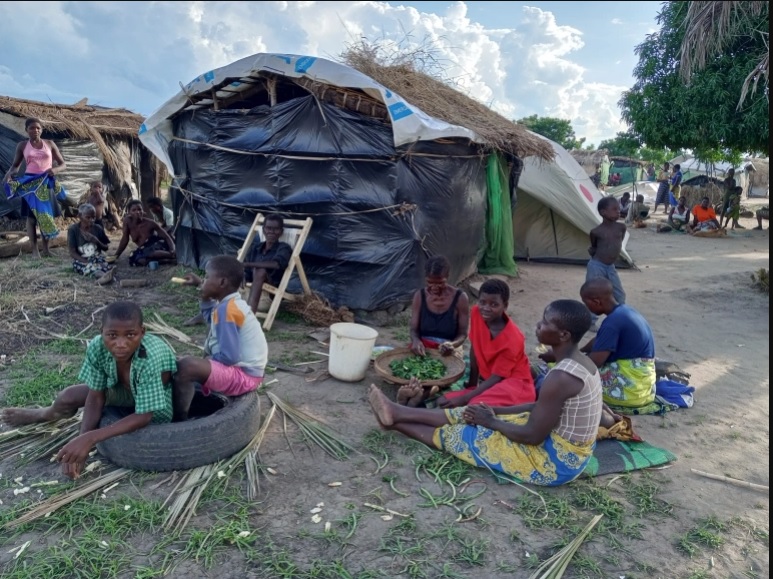Samson’s sacrifice
A few metres away from the joyful shouts of children playing soccer and the low whispers of women discussing the weather in small groups, Bernard Samson and other men are digging a pit latrine.
The 44-year-old father of six is a village head in Chikwawa. The man is used to leading a tall order.

In January, he sold his livestock to buy land for the 60 members of his community and save them from recurring floods.
“We were sleeping in classrooms at night and staying under the tree during the day,” Samson told Al Jazeera. “We stayed there for almost a week, but life was terrible and unbearable. When I saw how my people, especially children and the elderly, were struggling, I knew I had to come up with a plan.”
In January, Tropical Cyclone Ana triggered flooding in southern Malawi after sweeping from Madagascar through Mozambique.
The rainstorm forced Samson villagers to flee to a nearby primary school.
Frequent disasters
It was not the first flood in the district split by the Shire, the country’s largest river. A heavy downpour in 2015 and Cyclone Idai in 2019 caused more damage.
Ana affected a million people, according to the Department of Disaster Management Affairs (Dodma). Over 200 people were displaced, 206 injured and 46 dead.
Yet experts say the impact of the floods is still underestimated.
The villagers say the government and charities have not provided adequate support such as food aid.
In 2015, Dodma said it received only $80 million of the $495 million budgeted for recovery initiatives, from the Treasury.
When Idai struck, it needed even more to relocate the victims. This year, the department announced it need K68 billion (about $83m) for its four-month disaster recovery plan.
But its post-flood response has been too scanty and costly to execute, leaving citizens to fend for themselves.
Like thousands of other survivors, Samson fled at midnight when the flood was sweeping houses, livestock, crops and other personal possessions. They only had time to grab their children and run for their lives.
When the chief returned to his wrecked home, he saw that some of his cattle and goats had “miraculously” survived by climbing up a hill.
But he knew that if the displaced community returned to the same homes, they would only be flooded out again.
“There is no way these people could get money and buy land,” he said. “How about we sell this livestock and buy land upland so that they can survive?”
Samson sold the livestock at K600 000 and used K400 000 to buy land for each household. They quickly transformed the place dotted with dozens of temporary houses made of plastic sheets and thatched with grass.
“You should have seen the smile on their faces after hearing the news that I’ve secured them a place to live,” he said.
Jeffrey Mcheka, 75, who lost seven cows and six goats, says the chief’s sacrifice still leaves him speechless. Having built a makeshift residence, he is unwilling to go back.
“My wish is to have cultivating tools and fertiliser so that I can build a proper house after selling the produce and return to normal life,” he said.
Legal environment
Leaving the old homestead, where their ancestors are buried, was a tough call for the villagers.
“The land has been supporting us for years and it’s very fertile,” Samson said, looking downcast. “But the way water destroyed our homes was very scary and I don’t think anyone would want to see a repetition.”
The villagers said the river floods frequently because it is silted.
“I remember my parents telling me that the river was very deep. We need to be careful otherwise more lives will be lost,” said Samson.
Campaigners says flood-prone communities should be relocated to higher, safer ground, but allowed to maintain gardens in the low-lying lands.
But Dodma spokesperson Chipiliro Khamula ruled out the possibility of any relocation soon.
He said the government is implementing other measures such as protecting the villages with dykes, river training and reforestation.
Julius Ngoma, coordinator of the Civil Society Network on Climate Change said Chief Samson’s sacrifice calls for support from government and its partners.
He called for urgent mitigation work given the rising intensity and magnitude of natural disasters due to climate change.
“One critical issue is to make sure that we put in place very good early warning mechanism systems to help communities understand the likelihood of some of the risks manifesting into a disaster in their communities,” he said.
In 2015, draft law for disaster risk management, which creates room for establishing an intervention fund, was proposed to Parliament. Seven years later, it is yet to be passed into law.
“There is a lot of inaction by the government”, Ngoma said. “It doesn’t mean that government should do this alone, but they should put an enabling environment, including legislations so that other players can also come in firmly.”
Looking over the makeshift houses from his veranda, Samson is concerned about how his people can return to normal life.
“It was exciting to see that my people finally had something that they could call a home again,” he said. “It may not be like their previous home, but their dignity and privacy was restored.”






One Comment